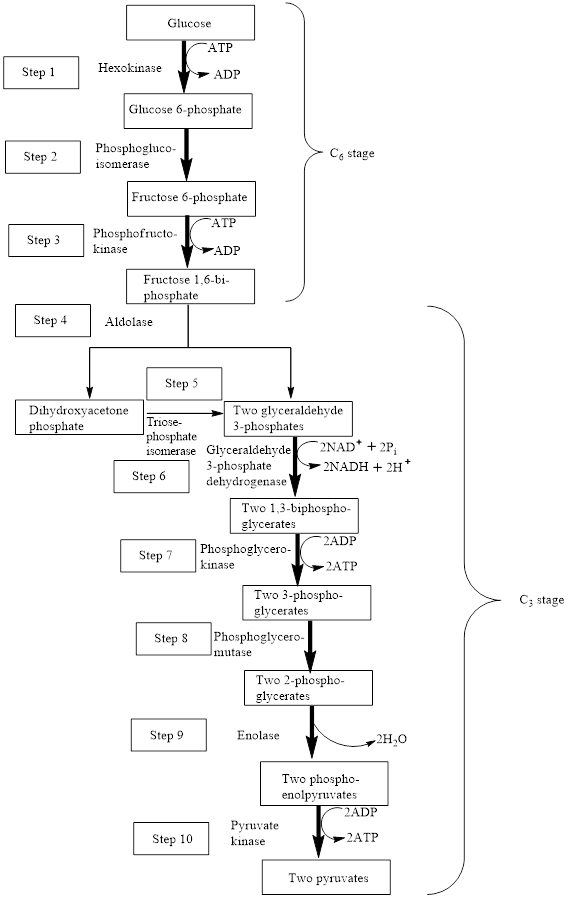
Concept explainers
(a)
Interpretation: To identify the name of the missing substance in the following word equation.
Concept introduction: Glycolysis is the
The block diagram to represent an overview of glycolysis is as follows:

From the above diagram, it is concluded that in the overall process of glycolysis, two stages are present.
a) Steps 1 to 3 represents a six-carbon stage
b) Steps 4 to 10 represent a three-carbon stage
The transfer of a phosphoryl group
(a)
Answer to Problem 13.19EP
The complete word equation is as follows:
Explanation of Solution
The first step in the glycolysis process is the phosphorylation of glucose using ATP. Glucose is converted to
In step 1, glucose is converted to
(b)
Interpretation: To identify the name of the missing substance in the following word equation.
Concept introduction: Glycolysis is the metabolic pathway that breaks down a glucose molecule and converts it into two pyruvate molecules along with the production of two ATP molecules and NADH reduced coenzymes.
The block diagram to represent an overview of glycolysis is as follows:

From the above diagram, it is concluded that in the overall process of glycolysis, two stages are present.
a) Steps 1 to 3 represents a six-carbon stage
b) Steps 4 to 10 represent a three-carbon stage
(b)
Answer to Problem 13.19EP
The complete word equation is as follows:
Explanation of Solution
In step 9,
In step 9,
(c)
Interpretation: To identify the name of the missing substance in the following word equation.
Concept introduction: Glycolysis is the metabolic pathway that breaks down a glucose molecule and converts it into two pyruvate molecules along with the production of two ATP molecules and NADH reduced coenzymes.
The block diagram to represent an overview of glycolysis is as follows:

From the above diagram, it is concluded that in the overall process of glycolysis, two stages are present.
a) Steps 1 to 3 represents a six-carbon stage
b) Steps 4 to 10 represent a three-carbon stage
A mutase enzyme catalyzes the isomerization reaction by shifting a functional group from one position to another position within a molecule.
(c)
Answer to Problem 13.19EP
The complete word equation is as follows:
Explanation of Solution
In step 8,
In step 8,
(d)
Interpretation: To identify the name of the substance in the following word equation.
Concept introduction: Glycolysis is the metabolic pathway that breaks down a glucose molecule and converts it into two pyruvate molecules along with the production of two ATP molecules and NADH reduced coenzymes.
The block diagram to represent an overview of glycolysis is as follows:

From the above diagram, it is concluded that in the overall process of glycolysis, two stages are present.
a) Steps 1 to 3 represents a six-carbon stage
b) Steps 4 to 10 represent a three-carbon stage
The transfer of a phosphoryl group
(d)
Answer to Problem 13.19EP
The complete word equation is as follows:
Explanation of Solution
The seventh step in the glycolysis process is the phosphorylation of
In step 7,
Want to see more full solutions like this?
Chapter 13 Solutions
Organic And Biological Chemistry
- Can a chemical that, in essence, goes through the body unchanged be an essential nutrient? Explain.arrow_forward2. These are known as metabolic reactions in which large biochemical molecules are broken down to smaller ones A. Anabolic reaction B. Catabolic reaction C. Metabolic reaction D. All of the above E. None of the abovearrow_forwardsome articifical sweeteners are isomers of natural sugars. Being isomers, the digestive enzymes do not recognize them and can do catabolize them (break them down). Write testable hypothesis regarding the catabolism of natural vs. artificial sweeteners by the model Eukaryotic organism, yeast. H0: HA:arrow_forward
- write a note on glycogen metabolismarrow_forward1. What are the primary, secondary and tertiary products of autoxidation reaction and their impact on food quality? 2. Enzymes produced by microorganism are responsible for spoiling food. Using this fact and your knowledge of enzymes, can you suggest a reason why some food such as onions, are preserved in vinegar. 3. explain why cooking egg denatures proteinarrow_forwardWhich control test tubes contained reducing sugars? Are these the results consistent with the sugars tested, explain? Sucrose and lactose are both disaccharides, explain why the test results are the same or different? Sucrose 8 minutes Blue color like Benedict's solution, not reaction. - Lactose 8 minutes orange-red color + Glucose 8 minutes Orange-red color +arrow_forward
 Introduction to General, Organic and BiochemistryChemistryISBN:9781285869759Author:Frederick A. Bettelheim, William H. Brown, Mary K. Campbell, Shawn O. Farrell, Omar TorresPublisher:Cengage Learning
Introduction to General, Organic and BiochemistryChemistryISBN:9781285869759Author:Frederick A. Bettelheim, William H. Brown, Mary K. Campbell, Shawn O. Farrell, Omar TorresPublisher:Cengage Learning Organic And Biological ChemistryChemistryISBN:9781305081079Author:STOKER, H. Stephen (howard Stephen)Publisher:Cengage Learning,
Organic And Biological ChemistryChemistryISBN:9781305081079Author:STOKER, H. Stephen (howard Stephen)Publisher:Cengage Learning, General, Organic, and Biological ChemistryChemistryISBN:9781285853918Author:H. Stephen StokerPublisher:Cengage Learning
General, Organic, and Biological ChemistryChemistryISBN:9781285853918Author:H. Stephen StokerPublisher:Cengage Learning Chemistry for Today: General, Organic, and Bioche...ChemistryISBN:9781305960060Author:Spencer L. Seager, Michael R. Slabaugh, Maren S. HansenPublisher:Cengage Learning
Chemistry for Today: General, Organic, and Bioche...ChemistryISBN:9781305960060Author:Spencer L. Seager, Michael R. Slabaugh, Maren S. HansenPublisher:Cengage Learning



